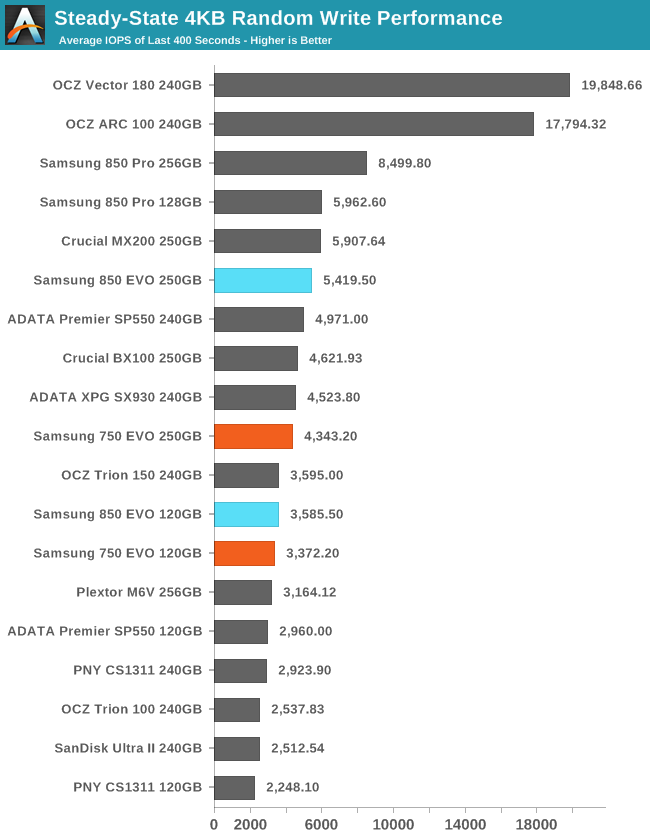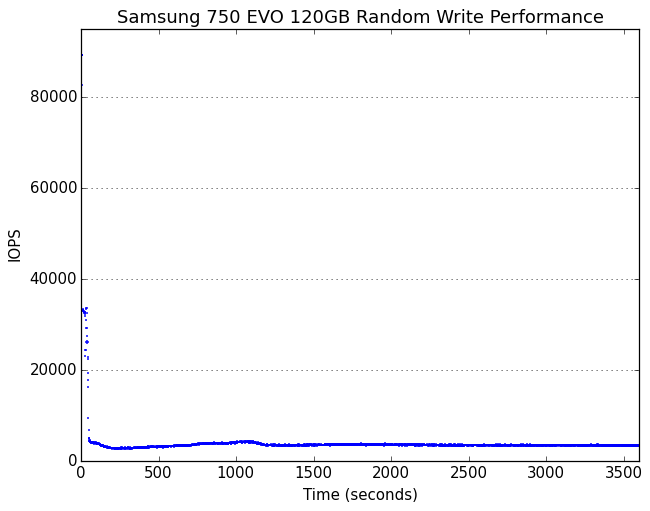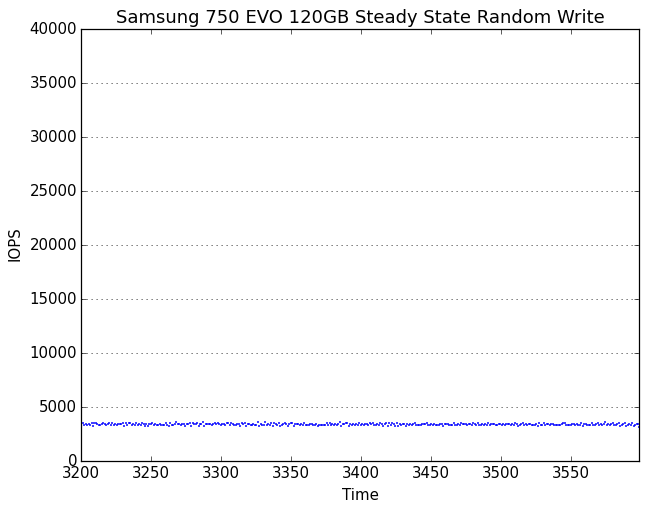The Samsung 750 EVO (120GB & 250GB) SSD Review: A Return To Planar NAND
by Billy Tallis on April 22, 2016 8:00 AM ESTPerformance Consistency
Our performance consistency test explores the extent to which a drive can reliably sustain performance during a long-duration random write test. Specifications for consumer drives typically list peak performance numbers only attainable in ideal conditions. The performance in a worst-case scenario can be drastically different as over the course of a long test drives can run out of spare area, have to start performing garbage collection, and sometimes even reach power or thermal limits.
In addition to an overall decline in performance, a long test can show patterns in how performance varies on shorter timescales. Some drives will exhibit very little variance in performance from second to second, while others will show massive drops in performance during each garbage collection cycle but otherwise maintain good performance, and others show constantly wide variance. If a drive periodically slows to hard drive levels of performance, it may feel slow to use even if its overall average performance is very high.
To maximally stress the drive's controller and force it to perform garbage collection and wear leveling, this test conducts 4kB random writes with a queue depth of 32. The drive is filled before the start of the test, and the test duration is one hour. Any spare area will be exhausted early in the test and by the end of the hour even the largest drives with the most overprovisioning will have reached a steady state. We use the last 400 seconds of the test to score the drive both on steady-state average writes per second and on its performance divided by the standard deviation.

Starting with a look at steady-state performance, the 750 EVO is clearly inferior to the 850 EVO, particularly at 250GB. But it outperforms most of the planar TLC competition and the occasional low-end MLC drive.

The high consistency score is a hallmark of Samsung's top-notch controller architecture. The 750 EVO is in an entirely different league from the planar TLC drives.
 |
|||||||||
| Default | |||||||||
| 25% Over-Provisioning | |||||||||
The 750 EVO's initial burst of high performance is relatively short-lived, but it transitions into a very well-regulated steady state. The gradual performance recovery before a second smaller drop in performance is less pronounced than on the other Samsung drives, but is still present.
With extra overprovisioning, the 750 EVO's steady state shows much looser performance regulation but is still delivering a better worst-case than its competition's best-case.
 |
|||||||||
| Default | |||||||||
| 25% Over-Provisioning | |||||||||
A closer look at the 750 EVO's steady state is pretty boring, with no clear patterns of periodic background maintenance or sporadic outliers.










109 Comments
View All Comments
Ascaris - Thursday, April 28, 2016 - link
Isn't that the truth! Nearly every item comes with glowing reviews mixed in with "mine died in xx time, and I am never going to buy from $company ever again." Consumer routers and hard drives seem particularly bad in that way-- if I avoided all of the ones with horror stories, I'd never have either of them.Another thing people tend to overlook in reliability is the role of a good power supply. A cheap PSU can slowly sap the life from all the components in the system by introducing unacceptable levels of ripple, and you'd never know that was a cause or partial cause of the failure. On a laptop with the brick-style power supply, it is a good idea to replace a failed unit with an OEM unit of recent manufacture (less chance of dried-up caps) than some eBay special of unknown origin (other than to say China, which is where the OEM one came from too, almost certainly).
For desktops, the PSU is something people sometimes skimp on. I've never actually had a prebuilt desktop, but I would bet a lot of them have cheap PSUs, as it is probably a place where pennies can be pinched without a huge increase in RMAs before the warranty expires. I looked at new PCs on the site of one of the major online sellers about a year ago, and I was surprised at how many current models still had 120/240v switches on the PSU, which shows that they are older models without active PFC. That does not necessarily mean they're of poor quality, but it does make me wonder about them.
BrokenCrayons - Friday, April 22, 2016 - link
I think it needs to come down in price before it'll be an acceptable sort of purchase.zepi - Friday, April 22, 2016 - link
SSD's have lost a lot by being so hamstrung by their interfaces. CPU's have limited number of PCI-e connections and motherboards very little space for M.2 slots. SATA 3 is slow and bad protocol for SSD so that race to the bottom is only thing that is of any interest in 2.5" drives.TheinsanegamerN - Friday, April 22, 2016 - link
SATA 3 may not be super fast, but the only observable difference, IME, between an m.2 drive and a sata drive was 2 seconds on boot. Unless you are a content creator working with laarge video/pictures, m.2 has little to offer over sata.Especially given that 2TB sata ssds exist, while m.2 is limited to 512GB, and that 512GB m.2 is more expensive than a 1TB sata ssd. And the ehat that m.2 drives give off compared to sata.
Margalus - Friday, April 22, 2016 - link
It may be "cheap", but it's worthless in my opinion. Only 120GB or 250GB, pretty much too small for anything except a boot drive. If there are no 1TB drives, why bother?TheinsanegamerN - Friday, April 22, 2016 - link
Believe it or not, many people could fit their computer needs in 250GB.I only use about 500GB between all of the games I actually play, and the OS itself.
Meteor2 - Friday, April 22, 2016 - link
Mmmm, I think a lot of people have digital media collections now. I have no DVDs or Blu Rays, but 600 GB of films and TV series.barleyguy - Friday, April 22, 2016 - link
Video doesn't need SSD levels of performance. Any modern spinning disk is fast enough to play video, even up to 4K.Personally, my video server machine is a 250 GB MX200 M-SATA SSD and a 4 TB hard drive.
Meteor2 - Saturday, April 23, 2016 - link
Absolutely but I want a single high-performance disc.Bleakwise - Sunday, April 24, 2016 - link
Why do you want an SSD for cold storage backups? That's just silly.